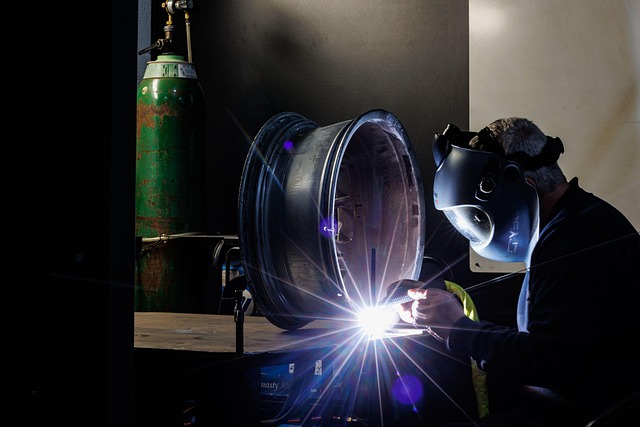Mastering B-Pillar Replacement: Step-by-Step Guide for Safe Vehicle Restoration
TL;DR: Assessing a B-pillar's structural integrity through expert inspection is crucial before…….
Welcome to an in-depth exploration of a transformative concept in the realm of automotive engineering and safety: B-pillar replacement. This article aims to guide you through the intricacies of this groundbreaking initiative, its global impact, and the many facets it touches. By the end, readers will grasp why B-pillar replacement is not just a technical upgrade but a catalyst for innovation, sustainability, and enhanced vehicle safety standards worldwide.
Definition: B-pillar replacement refers to the process of designing, developing, and implementing new or improved structural pillars (or columns) in motor vehicles, typically the B-pillars located between the doors and roof. These pillars play a critical role in vehicle rigidity, crashworthiness, and overall structural integrity.
Core Components and Historical Context: Traditionally, B-pillars have been constructed from steel or aluminum, contributing to a vehicle’s strength and stability. However, advancements in materials science and engineering have prompted a reevaluation of their design. The modern approach involves sophisticated material selection, advanced manufacturing techniques, and innovative structural configurations. This evolution is driven by the dual goals of enhancing safety and optimizing vehicle weight and efficiency.
Significance: B-pillar replacement is not merely an upgrade; it’s a pivotal step in automotive design. Here’s why:
The concept of B-pillar replacement has captivated automotive manufacturers and regulators worldwide. Here’s an overview of its international influence and key trends:
| Region | Trends | Impact |
|---|---|---|
| North America | Focus on lightweight materials, particularly high-strength steel (HSS) and advanced composites. Strict safety regulations drive innovation. | Improved vehicle safety and fuel efficiency. |
| Europe | Emphasis on aluminum and carbon fiber reinforced polymers (CFRP). Stringent CO2 emission standards prompt lighter, more efficient designs. | Reduced environmental impact and enhanced performance. |
| Asia-Pacific | Rapid adoption of advanced steel alloys and composite materials. Increasing demand for electric vehicles (EVs) influences B-pillar design for better range and efficiency. | Higher safety standards and lightweighting trends across the board. |
| Emerging Markets | Local manufacturers adopt global best practices, incorporating lightweight materials where feasible. | Improved vehicle performance and safety at competitive prices. |
Global automotive giants like Volkswagen, Toyota, and General Motors are at the forefront of B-pillar replacement research and development. These companies invest heavily in advanced materials and manufacturing processes to stay ahead of evolving regulations and consumer demands.
The economic implications of B-pillar replacement are far-reaching, impacting various sectors:
Market Dynamics:
Investment Patterns:
Technological breakthroughs play a pivotal role in shaping the future of B-pillar replacement:
Material Innovations:
Manufacturing Techniques:
Sensor Integration: Future B-pillars may incorporate sensors for enhanced vehicle dynamics and active safety features, contributing to autonomous driving capabilities.
Government policies and regulations significantly influence the pace and direction of B-pillar replacement:
Despite its numerous benefits, B-pillar replacement faces certain challenges and criticisms:
Challenges:
Criticisms:
Solutions and Strategies:
Tesla’s Model 3 showcases innovative B-pillar replacement through its unique design and structural integrity. The vehicle features a sleek, low center of gravity achieved through the strategic use of lightweight materials, including advanced steel alloys and aluminum. This design contributes to improved handling and reduced weight, enhancing overall efficiency.
Volvo’s XC90 is renowned for its safety features, and its B-pillars play a critical role. The car employs high-strength steel B-pillars reinforced with composite materials, providing exceptional crash protection while maintaining a lightweight profile. This case illustrates how B-pillar replacement can enhance both structural integrity and vehicle dynamics.
Toyota’s hybrid Prius demonstrates the impact of B-pillar replacement on fuel efficiency and design. The hybrid model’s advanced aluminum B-pillars contribute to its lightweight construction, improving fuel economy and reducing emissions. This case highlights the role of B-pillar technology in achieving sustainable transportation goals.
The future of B-pillar replacement is filled with promising possibilities:
Growth Areas:
Emerging Trends:
Strategic Considerations:
B-pillar replacement is more than a technical advancement; it’s a catalyst for innovation, safety, and sustainability in the automotive sector. As global trends continue to push for lighter, more efficient vehicles, this technology will play an increasingly vital role. The future holds immense potential for B-pillar replacement to shape the way we design and experience motor vehicles, ensuring safer, greener, and more technologically advanced transportation.
Q: How does B-pillar replacement impact vehicle performance?
A: Contrary to some concerns, B-pillar replacement can actually enhance vehicle performance by improving structural rigidity and handling. Lighter materials and optimized designs contribute to better acceleration, braking, and cornering capabilities.
Q: Are there any environmental concerns with advanced composite materials?
A: While the production of certain composite materials may have environmental impacts, life cycle assessments show that their benefits, such as reduced weight and fuel consumption, often outweigh these concerns. Responsible sourcing and recycling practices are essential to minimize any adverse effects.
Q: Can B-pillar replacement contribute to better vehicle dynamics?
A: Absolutely! Advanced B-pillars can be engineered to provide improved vehicle stability, reduced roll over, and enhanced cornering performance, leading to a more responsive and enjoyable driving experience.
Q: How do regulatory bodies ensure the safety of new B-pillar designs?
A: Regulatory agencies conduct rigorous testing and evaluation of B-pillar designs, simulating various crash scenarios to ensure they meet or exceed safety standards. These tests are essential to validate the performance of new materials and structures in real-world conditions.

B-pillar replacement is a critical process in the automotive industry that goes beyond cosmetic repa…….

The modern B-pillar, a critical structural element in vehicles, has evolved from a vertical support…….

B-pillar replacement is a critical process in collision repair centers, vital for vehicle safety and…….

B-pillar replacement is a technical process crucial for vehicle safety and stability, especially dur…….

The B-pillar, a vital automotive structural element, requires regular maintenance and replacement du…….